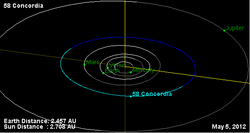Astronomy:58 Concordia
 Orbital diagram | |
| Discovery | |
|---|---|
| Discovered by | Karl Theodor Robert Luther |
| Discovery date | March 24, 1860 |
| Designations | |
| (58) Concordia | |
| Pronunciation | /kənˈkɔːrdiə/[1] |
| Named after | Concordia |
| Minor planet category | Main belt Nemesis |
| Adjectives | Concordian |
| Orbital characteristics | |
| Epoch December 31, 2006 (JD 2454100.5) | |
| |{{{apsis}}}|helion}} | 2.818 AU (421.526 Gm) |
| |{{{apsis}}}|helion}} | 2.583 AU (386.457 Gm) |
| 2.701 AU (403.991 Gm) | |
| Eccentricity | 0.043 |
| Orbital period | 4.44 a (1620.946 d) |
| Mean anomaly | 15.122° |
| Inclination | 5.057° |
| Longitude of ascending node | 161.290° |
| 34.465° | |
| Physical characteristics | |
| Dimensions | 93.4 km |
| Mass | ~5.89×1017 kg (calculated) |
| Mean density | 1.38 g/cm3 (assumed)[2] |
| Rotation period | 9.895±0.001 h[3] |
| Geometric albedo | 0.058[4] |
| C | |
| Absolute magnitude (H) | 8.86 |
Concordia (minor planet designation: 58 Concordia) is a fairly large main-belt asteroid that is orbiting the Sun with a period of 4.44 years, a semimajor axis of 2.7 astronomical unit|AU, and a low eccentricity of 0.043. It is classified as a C-type asteroid, meaning that its surface is very dark and it is likely carbonaceous in composition. The surface spectra displays indications of hydrated minerals created through aqueous alteration.[5] The object is rotating with a sidereal period of 9.894541 h and pole orientations of (15.3°±0.7°, −4.2°±2.6°) and (195.9°±1.0°, 4.8°±1.2°).[6] It belongs to the Hungaria family of asteroids and has a satellite with an orbital period of 14.29 h.[3][dubious ]
Concordia was discovered by German astronomer Robert Luther on March 24, 1860. At Luther's request, it was named by Carl Christian Bruhns of the University of Leipzig after Concordia, the Roman goddess of harmony.[7]
References
- ↑ "Concordia". Dictionary.com Unabridged. Random House. https://www.dictionary.com/browse/Concordia.
- ↑ https://ui.adsabs.harvard.edu/abs/2002Icar..158...98K
- ↑ 3.0 3.1 Pilcher, Frederick (October 2016), "Rotation Determinations for 50 Virginia, 58 Concordia 307 Nike, and 339 Dorothea", The Minor Planet Bulletin 43 (4): 304–306, Bibcode: 2016MPBu...43..304P.
- ↑ Asteroid Data Sets
- ↑ Fornasier, S. et al. (May 2014), "Aqueous alteration on main belt primitive asteroids: Results from visible spectroscopy", Icarus 233: 163–178, doi:10.1016/j.icarus.2014.01.040, Bibcode: 2014Icar..233..163F.
- ↑ Jiang, P. F.; Wang, X. B. (September 2018), "Photometric Study on Asteroid (58) Concordia", Acta Astronomica Sinica 59 (5), 46, Bibcode: 2018AcASn..59...46J.
- ↑ Schmadel, Lutz D. (2003). Dictionary of Minor Planet Names. Springer Science & Business Media. p. 20. ISBN 978-3-540-00238-3. https://books.google.com/books?id=KWrB1jPCa8AC&pg=PA20.
External links
- 58 Concordia at AstDyS-2, Asteroids—Dynamic Site
- 58 Concordia at the JPL Small-Body Database
 |

